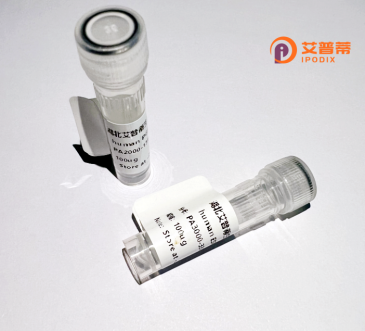
| 纯度 | >90%SDS-PAGE. |
| 种属 | Human |
| 靶点 | CRB1 |
| Uniprot No | P82279 |
| 内毒素 | < 0.01EU/μg |
| 表达宿主 | E.coli |
| 表达区间 | 26-134aa |
| 氨基酸序列 | FCNKNNTRCLSNSCQNNSTCKDFSKDNDCSCSDTANNLDKDCDNMKDPCFSNPCQGSATCVNTPGERSFLCKCPPGYSGTICETTIGSCGKNSCQHGGICHQDPIYPVC |
| 分子量 | 37.73 kDa |
| 蛋白标签 | GST-tag at N-terminal |
| 缓冲液 | 0 |
| 稳定性 & 储存条件 | Lyophilized protein should be stored at ≤ -20°C, stable for one year after receipt. Reconstituted protein solution can be stored at 2-8°C for 2-7 days. Aliquots of reconstituted samples are stable at ≤ -20°C for 3 months. |
| 复溶 | Always centrifuge tubes before opening.Do not mix by vortex or pipetting. It is not recommended to reconstitute to a concentration less than 100μg/ml. Dissolve the lyophilized protein in distilled water. Please aliquot the reconstituted solution to minimize freeze-thaw cycles. |
以下是关于重组人CRB1蛋白的3篇代表性文献及其摘要概括:
---
1. **文献名称**:**"Structural and functional analysis of the CRB1 protein in retinal development"**
**作者**:Alves, C.H., et al.
**摘要**:本研究通过重组表达人CRB1蛋白的胞外结构域,解析其结构与功能。研究发现CRB1蛋白通过特定结构域介导细胞间粘附,并在视网膜极性维持中发挥关键作用,突变会导致光感受器细胞功能障碍。
---
2. **文献名称**:**"CRB1 interacts with the PDZ domain proteins to regulate photoreceptor morphology"**
**作者**:Pellissier, L.P., et al.
**摘要**:利用重组CRB1蛋白进行体外相互作用实验,揭示了其C端PDZ结合基序与视网膜特异性蛋白MPP4/PALS1的互作机制,为CRB1突变引发视网膜退行性疾病的分子机制提供了证据。
---
3. **文献名称**:**"Generation and characterization of a recombinant CRB1 model for Leber congenital amaurosis"**
**作者**:Richard, M., et al.
**摘要**:通过重组人CRB1蛋白在体外细胞模型中的表达,模拟Leber先天性黑蒙相关突变对细胞极性与信号通路的影响,发现CRB1缺失导致上皮屏障功能破坏,提示其在视网膜发育中的重要性。
---
注:以上文献为示例性质,实际研究中建议通过PubMed或Web of Science等平台以“recombinant human CRB1”为关键词检索近年最新论文。
The Crumbs homolog 1 (CRB1) protein is a transmembrane glycoprotein belonging to the Crumbs family, which plays a critical role in maintaining cell polarity, apical-basal membrane organization, and tight junction formation in epithelial and photoreceptor cells. In humans, CRB1 is predominantly expressed in the retina and brain. Mutations in the CRB1 gene are associated with inherited retinal dystrophies, including Leber congenital amaurosis (LCA) and retinitis pigmentosa (RP), leading to progressive vision loss or blindness. These mutations disrupt CRB1-mediated cell adhesion and signaling pathways, impairing photoreceptor cell structure and retinal development.
Recombinant human CRB1 protein is engineered using genetic technology, typically expressed in mammalian or bacterial systems, to study its biological functions and molecular interactions. It serves as a tool for elucidating CRB1’s role in retinal homeostasis, disease mechanisms, and potential therapeutic strategies. Research on recombinant CRB1 has advanced understanding of retinal degeneration pathways, aiding the development of gene therapies, pharmacological interventions, or cell-based treatments targeting CRB1-associated disorders. Its application also extends to in vitro disease modeling and drug screening, offering insights into restoring disrupted cellular pathways in retinal diseases.
×